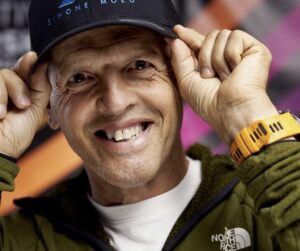Every season since 2003, there is a team at Everest Base Camp whose members are not hoping to reach the summit. They are the volunteer doctors at the Everest ER clinic. While not often mentioned in climbers’ Instagram posts, they carry out remarkable work for everyone, but most of all for local workers.
“We treat anyone who needs our medical services,” Dr. Sanjeeb Bhandari, co-medical director of the Everest ER clinic and assistant medical director of the Himalayan Rescue Association, told ExplorersWeb. “The team provides medical services to Nepali people for free and charge client climbers for consultation and medicine.”
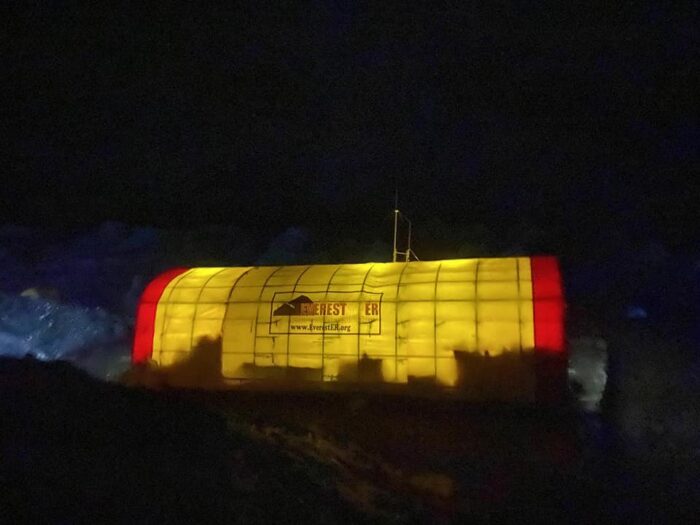
The staff works 24 hours a day through the Everest climbing season. Photo: Himalayan Rescue Association (HRA)
Bhandari added: “Every year we see 450 to 650 patients. Most of them have upper respiratory tract infections along with AMS (acute mountain sickness), HAPE (high altitude pulmonary edema), HACE (high altitude cerebral edema), frostbite, and a few traumas with broken bones.”
The HRA began in 1978, with a small aid post in Pheriche. The Everest ER clinic at Base Camp) launched in 2003. By 2011, Nepalese physicians were also volunteering for the clinic.
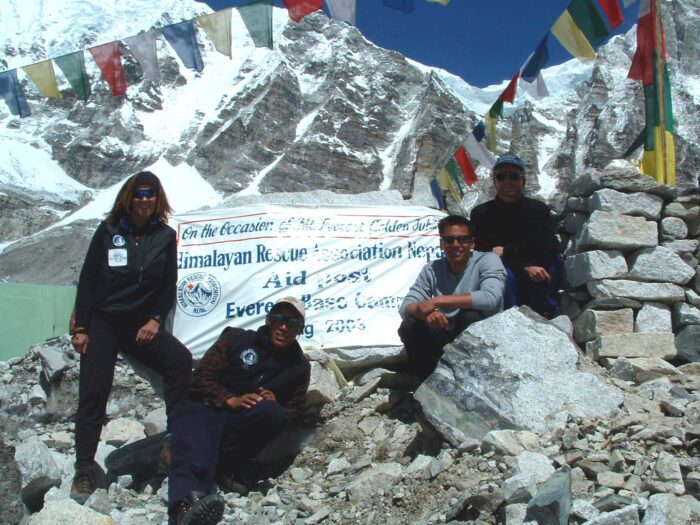
The first Everest ER season in 2003. Left to right: Dr. Luanne Freer, Lakpa Sherpa, Dr. Brian Gee, and med student Eric Hung. Photo: HRA
“The Everest ER started with a small tent with basic medical supplies. [Now we have] a bigger tent with ECG and ultrasound capabilities,” Bhandari said. “We leveled up with the evolution and the availability of helicopter rescue. Initially, patients needing rescue used to be carried down on someone’s back, on a stretcher, or on a horse to the Pheriche aid post. Now helicopters carry out most of the rescues, taking patients to Lukla, if not to Kathmandu.”
This year, the clinic counts on the leadership of Dr. Gregory Stiller of the U.S. and Nepalese MBBS Shreyasi Karki and Nishant Joshi. The team also includes long-line rescue specialist Lakpa Norbu Sherpa. The staff is currently in Pheriche, where they have already attended to some patients, mostly suffering from AMS.
Why volunteer?
ExplorersWeb spoke with Dr. Joshi, currently in Pheriche but on his way to Everest ER later this week. Joshi worked at the Pheriche aid post and Gosaikunda Lake last year. This year will be his first experience at the Base Camp clinic.
“Working at altitude exposes you to various pathologies you would never see normally,” he said about his voluntary work. “It also exposes you to the daily hardships people deal with here. It is an eye-opening experience.”
Last season, there were more than 50 patients with HAPE, the highest since the clinic opened 50 years ago. Almost 45 of them were Nepalese guides and porters, Joshi pointed out.
He noted that charging six insured trekkers (who usually have the money refunded by their insurance companies) is enough to pay for the treatment of all 45 guides and porters.
“It is a rewarding experience to be able to help just for the sake of helping,” Joshi said.
He remembers a sherpa lady who asked for his name to dedicate prayers to him at the monastery.
“Nowhere in the world would I have such a healthy doctor-patient relationship as this. That experience made me want to come back.”
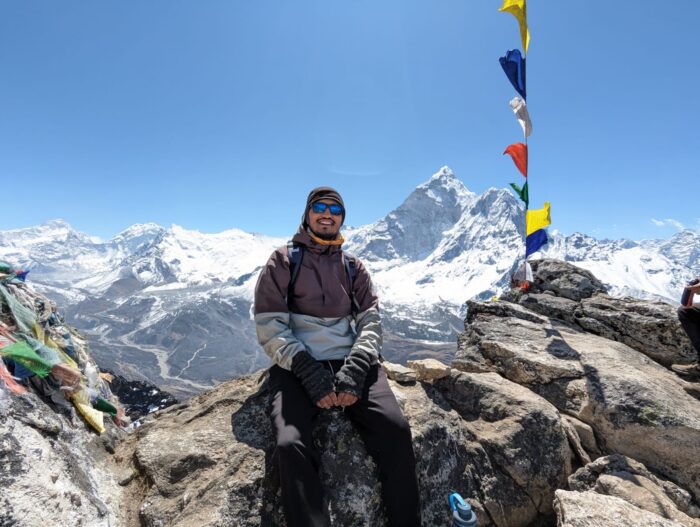
Joshi is a medical graduate from the Patan Academy of Health Sciences. He is on his way to the Everest ER clinic. Photo: HRA
Joshi explained that the doctors devote most of their work to local people. Locals are already over-exerted by hard work and are therefore the most vulnerable.
“I did a lot of night shifts looking after patients who would be carried to us at midnight from higher altitudes. When I provide medication and consultations, I would find myself sitting and staring at the stars and mountains reflecting moonlight, grateful that I could help someone who would have died had someone not volunteered in a place like this.”
Growing beyond Everest
In addition to the field hospital at EBC, the Himalayan Rescue Association (HRA) runs aid posts on two of the most popular trekking routes in Nepal. There is one post in Pheriche, on the way to Everest Base Camp, and another in Manang town, in the Annapurna region.
“In August, we also run a temporary health camp at 4,200m Gosainkunda Lake (Langtang) when it receives 20,000 pilgrims over four days. Most of them are Nepalese nationals with little to no knowledge about high-altitude illnesses.”
As a non-profit, the HRA depends on donations. These come largely from individuals, with a little from Nepal’s government. Should their budget increase in the future, they would expand their work to other Base Camps, especially the very popular Manaslu during fall season.
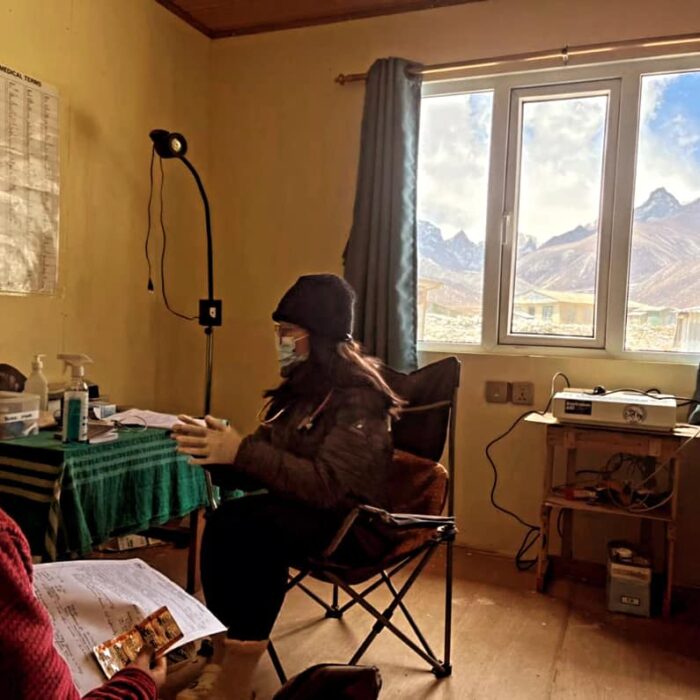
Dr. Shreyasi Karki at work in the HRA’s aid post in Pheriche last weekend. Photo: HRA
Field workers attend to medical emergencies but they are aware that prevention is much better than curing sickness. That is why they also run educational training in their Kathmandu office for teams preparing for an expedition.
“From a medical prevention perspective, educating the climbers is key,” the HRA staff explain. “Frequency of illness has decreased because of preventative efforts by us to educate the climbers and the Everest Base Camp community.”
The health front line
The staff at the aid post and the Everest ER clinic are mainly busy with emergencies. However, as the first line of medical assistance, they are aware of the array of health problems faced by men and women who work at high altitude, not only during the season but throughout their lives.
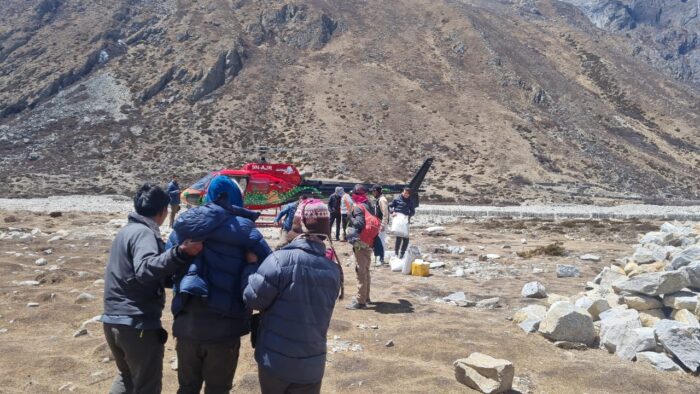
A patient suffering from HACE is helped to a helicopter at the aid post in Pheriche. Photo: HRA
“There are many chronic medical issues we deal with every day at the clinic: gastritis, heart issues, hypertension, diabetes, etc. For many issues we direct them to centers that specialize in the appropriate care,” Joshi said.
The clinic also covers mental health issues. “We receive panic attacks, conversion disorder, and patients with depression. We counsel, appropriately assess the severity of the symptoms, and treat or refer them accordingly,” Joshi said.
In a few weeks, we will check in with Dr. Joshi for an update on the medical situation at Everest Base Camp.




